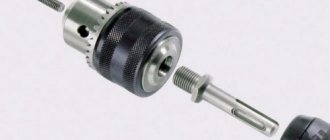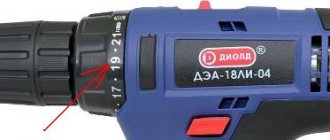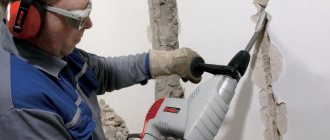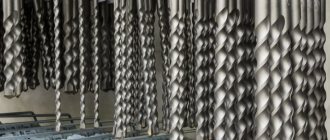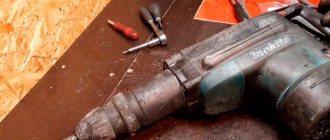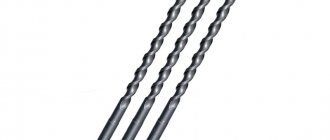The term hammer literally refers to a drilling hammer, as it was originally used by miners to extract stone. It was conceived as a shock-type action model.
With the help of a flywheel and transmission mechanisms, a rod connected to a pusher was raised. The spring pushed it down, the blow was delivered due to the forces of inertia and compression of the spring. Mainly used for hard rocks.
The pneumatic hammer drill was invented in 1857 by French engineer Sommelier. In 1932, the first model with electric drive was introduced.
What is a hammer drill
A hammer drill is a universal tool that has great capabilities. Inside it there is a pneumatic device that pushes the piston, which comes into contact with the striker. The latter forces the equipment to perform reciprocating movements. As a result, the nozzles destroy any surface. The presence of the impact function allows the tool to make holes in hard materials.
Its purpose depends on the built-in modes: drilling, chiselling and drilling . There is a toggle switch to switch modes.
Manufacturers produce models of different weights:
- up to 4 kg – light;
- from 4 to 5 kg – average;
- from 5 kg – heavy.
The power and impact force depend on the size of the hammer drill .
Perforator device
Rotary hammer equipment
Most often it is used to work with :
- concrete;
- brick;
- stone;
- reinforced concrete;
- metal.
Rarely - with wood. The variety of materials requires the presence of a large number of attachments (working body) :
- drill;
- borax;
- chisels;
- crowns
All of them are designed to perform different jobs. Drills are used to make neat holes in the surfaces of the required diameter and depth.
Products that are intended for work on such a durable material as concrete are made using carbide plates . They are soldered onto the cutting part. But during use they wear out.
How to sharpen concrete drill bits for a rotary hammer? Sharpening can be done on a corundum grinding wheel, which is installed on appropriate equipment. The drill must be sharpened so that the worn cutting edges become straight, and the place where they intersect exactly coincides with the axis of rotation of the hammer drill. You should also pay attention to the sharpening angle of the two cutting edges . If this parameter is uneven, the edge with a large sharpening angle will be more heavily loaded. As a result, the hammer drill will quickly fail.
Drills are designed for piercing high-strength materials . A tool with a drill bit simultaneously drills, vibrates or impacts. This work is necessary when installing an outlet. When a chisel or spatula is installed on the device, it works like a jackhammer.
The type of fastening for all attachments, except for drills, is only suitable for a hammer drill, because it has fastenings in the form of grooves and a mounting tail . You can attach a regular drill bit from a drill to a hammer drill; you need a removable chuck (adapter). It comes in two types: cam and quick-clamping. A special key is used to secure the cam clamp. It is inserted into the thread on the outer perimeter and turned. At this time, the collet mechanism, which is installed inside the chuck, is compressed or unclenched, depending on the direction in which the key is moved.
The keyless chuck is activated by applying slight force by hand. The drill hole will open when you press down on the chuck.
There is also a small elongated design that allows you to lengthen the drills . Thanks to the extension, you can make deeper through holes in different materials. When drilling using it, you should carefully adjust the cutting conditions.
Different drills are needed for different materials
Opening
Used for punching holes with diameters of 45-80 mm in brickwork, concrete and sand-lime brick. Suitable for laying pipelines and cables.
Design Features:
- the drilling head has a bell shape and an asymmetrical arrangement of shanks;
- the cutting edge is made of hard alloy;
- Efficient operation is ensured by a large spiral with a long conical shank;
- Precise drilling is ensured by a drill in the center;
- the design of the head is made in such a way as to reduce friction in the hole being made, which allows you to perform work much faster;
- Designed for through holes.
Installing a drill into a hammer drill
The tool itself also has a quick-release mechanism . The drill is securely secured in it with the help of special balls; when locked, they fit tightly into the grooves that are located on the bottom of the drill. The installation procedure looks easy. To secure the bit or drill bit, the lower part of the chuck is moved towards the hammer drill (down). Holding it in this position, install the necessary equipment and release the cartridge. It happens that the balls do not fit into the grooves, and as a result the nozzle moves; you need to turn it until the structure is completely closed.
If a drill needs to be inserted into a hammer drill using an adapter, then you first need to install and fix a removable chuck with grooves for attaching it to the tool, and then the drill itself.
Before inserting or removing a drill into a Bosch hammer drill, be sure to check the condition of the tool . Then they turn it on, set the desired mode, and press the start button. You can start working if there is no smell of burnt plastic or burning, and there are no strange sounds.
Possible problems with attaching the nozzle
It happens that the installation of a drill or auger into a hammer drill chuck ends in failure. This word refers to defects in the fit and rotation of the drilling attachment, and unreliable fastening of the chuck. Most often there are 2 cases:
- The drill is not securely fixed in the socket and flies out during operation. In 99% of cases, the source of the problem is a worn cartridge. You can take it apart and try to restore it.
Disassembling the chuck
In the clamping mechanism, the cams often become deformed over time and deviate from their normal position. It could also be compression due to wear on the retaining spring. The mentioned parts cannot be repaired, so they should be replaced and the entire structure put back together. If there is no desire or time, it is better to immediately purchase a new cartridge.
- It also happens that the cartridge does not want to be attached to the hammer drill shaft. Here, the probable cause also lies in wear, this time of the retaining ring at the end of the raster sleeve. Using this part, the chuck body is attached to the shaft of the power tool. Replacing the retaining ring will help here.
Bottom left – retaining ring
How to remove a drill with a working chuck
With a working chuck, getting a drill is absolutely not difficult. If the cartridge has a key clamp , a special key is needed; in the quick-release fastener, manipulations are performed by hand. In the first option, remove it by inserting the key into one of the recesses on the cartridge and rotating it counterclockwise. Thanks to the teeth present on both objects, unwinding occurs.
In a situation with a quick-release fastening, the hammer drill is switched on in reverse rotation mode . Hold the outer body of the cartridge with one hand and press the start button with the other.
After removing the used nozzle and before replacing it, the shank is cleaned of construction dust and old grease. The shank of the drill being installed must be cleaned and lubricated. When prepared for work, it will last much longer; lubrication extends the life of the hammer drill and attachments.
Tools without reverse only use key chucks. Rotary hammers without reverse are considered a bad purchase.
What to do if the drill does not budge
The drill may become stuck so that it cannot be moved. How to remove the drill from the hammer drill in such a situation? To remove the part of the nozzle that sticks out, you need to clamp it in a vice. Tap the chuck with a hammer to avoid damaging the tool; use a wooden adapter. When the tail of the jammed drill appears from the chuck, stop knocking.
If these steps do not help remove the nozzle, the cartridge is completely removed and placed in gasoline. Pour car oil and leave for 1 hour. Afterwards they try to extract it again.
Very often during repair work, the drill gets stuck in the wall . When you have to pull it out, you don’t have to pull the trigger and pull. This way you can break it. It is also impossible to loosen the tool too much, as the drill may break and a piece of debris will remain. You can drill another hole nearby with a drill, slightly loosen the hammer drill, and try to remove it.
If this does not help, use a gas wrench . They screw it onto a drill and hit it against the handle with a hammer from the wall. If the key is very large, use a steel plate as a spacer.
If you need to remove a drill that is stuck through, you can do this with a sledgehammer . They hit it in the direction of drilling. Do not hit the drill itself. To soften the blows, you need to put a board or any padding.
To avoid this problem, you need to remove the attachments more often. Remove dust from the drilled hole, remove various contaminants, and pieces of the material being processed.
The drill can jam in the surface if too much pressure . The hammer drill should be easy to operate. The reinforced concrete structure contains metal reinforcement, so a drill can easily get stuck in it. Before starting work, experts advise using a special device to check where these metal elements are located.
The drill is easily installed in a working tool
Some tips for using the tool
It would be useful to remind you how to work with a hammer drill. This information will be useful for novice builders.
- Use protective equipment when working: earplugs, gloves, safety glasses.
- Do not exert any force on the hammer drill during operation.
- Idle operation of the device is unacceptable.
- If the material being processed has increased hardness, then it is necessary to apply a lubricant. An alternative to lubricant is regular machine oil.
- If a long drill is used, the drilling must be made shorter.
- To increase the service life of the tool, it is necessary to periodically cool the drill in water or oil and take breaks from work.
The hammer drill has firmly entered the life of the builder and installer today. If treated properly, this tool will serve for a long time.
With the advent of reinforced concrete structures, not a single internal or external repair can be completed without a hammer drill. There is a wide variety of such devices on the market. However, the basic mechanisms work approximately the same. This statement is true primarily for the process of reinstalling drills.
How to remove a drill from a damaged chuck
in the chuck are often damaged or the cam breaks . The drill may break when twisted between the jaws. Chips appear and fall into the cracks, preventing them from rotating normally. Using 2 gas keys, each part of the cartridge is clamped with one of the keys and rotated and unscrewed. You can use 1 key and a vice, in which case one part is clamped in a vice.
If there is no gas key, one half must be inserted and clamped in a vice , the other half should be lightly hit tangentially with a hammer.
If the threads on the cams are torn off, these methods are useless. In this case, the cartridge is twisted. Place in a vice. The drill is knocked out from the inside with a punch. It is threaded through the hole into which the spindle .
Design and principle of operation of devices of the SDS category
The design and principle by which the drill chuck of this category works is quite simple.
- The drill shank has two open guide grooves that move along the chuck splines located in its inner part. Due to the interaction of the internal splines of the chuck and the guide grooves of the shank, torque is imparted to the tool.
- There are also closed grooves on the drill shank, which, combined with the ball clamps of the chuck, prevent the tool from falling out. The SDS chuck is designed in such a way that no load is placed on the ball clamps during machining.
- In order to transfer the impact load to the end of the drill, the hammer drill uses a so-called hammer, driven by a pneumatic or electric drive.
Scheme of the clamping-drive unit of the hammer drill
To remove or install a tool with an SDS shank, follow these steps:
- by pulling the movable ring of the chuck, release the ball clamps and remove the drill ;
- lower the ring (thereby fixing it with the help of balls that fit into the closed grooves of the shank) to install the drill .
What to do if the drill breaks
If you can get caught on the tip of a stuck drill bit, pull it out :
- pliers;
- wire cutters;
- tweezers.
Often it gets stuck very deep. To remove a piece of debris, you need to take into account its diameter, size and type of metal, where it is stuck, and also how deep. To remove a small fragment, the hole in which it is lodged is enlarged. The fragment is pryed with a suitable device and pulled out.
You can remove a piece of a broken drill with a diameter of 8 mm or more that remains in the metal using a bolt with welded spokes or a spring wire . But this is if its end sticks out, which you have to cling to.
The tail part remaining in the socket can be removed using a welding machine, thin electrodes, or a thin plastic tube . The latter must match the diameter of the cartridge bore. The tube is inserted into the socket and rests against the fragment. Turn on the welding, connect the mass to the tool, press the chuck lock to the nozzle release mode, and carefully insert the electrode into the plastic tube. And they quickly weld the electrode to the shank in order to later remove the broken part.
If the shank is dented, the chuck will have to be partially disassembled. The fragment cannot be pulled out even by welding the electrode .
Most often, poor quality attachments break. It is advisable to purchase high quality equipment . During operation, try not to jam. If you have to drill with a low-quality drill, do not put pressure on it. You can understand the quality of the equipment by making several holes and then looking at the shank. A good product does not wrinkle.
Sometimes the drill breaks and this requires additional work
Is it possible to insert a regular drill bit into a hammer drill?
In some situations, you need to screw a drill from a simple drill into a . This can be done using a special adapter, which is a regular cartridge. Electric drills are equipped with it. It comes in 2 types: key and quick-clamping. A special adapter is inserted into the cartridge, which must be tightened tightly. On one side there is a shank, like a regular drill, on the other there is a thread. It can be different. Mostly 1/2 inch and metric type - M12. The adapter must have similar threaded fittings . It is screwed into the cartridge and secured with a special screw with a left-hand thread. It is included in the kit.
The assembled structure is placed into the hammer drill in the same way as a drill. This turns out to be a standard electric drill. You just need to keep in mind that in such a tool the cartridge will have some play . The assembled adapter is not able to withstand heavy loads, so the shock mode must be disabled. Manufacturers produce rotary hammers that already come with similar adapters. There are also models that contain several cartridges at once, which replace each other. One for installing the drill, the other for the drill.
This configuration has an important advantage - no backlash , since the adapter is suitable specifically for a specific hammer drill model. This one costs more.
Violations of work rules
Safe drilling requires adherence to certain rules, failure to comply with them may result in injury or damage to the tool. The drill chuck is in greatest danger, taking on the main load when in contact with the surface. To avoid unpleasant consequences, it is not recommended to sharply change the drilling angle. It is also necessary to limit the applied force on the drill whose drill bit is in the process of drilling. Excessive load may cause the drill to break or jam in the chuck. To machine heavy-duty surfaces, you must use drills designed for this type of work.


